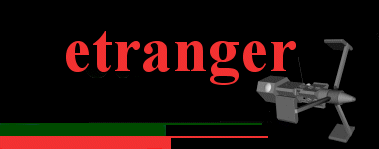Patrie and Soldat-class
Destroyers
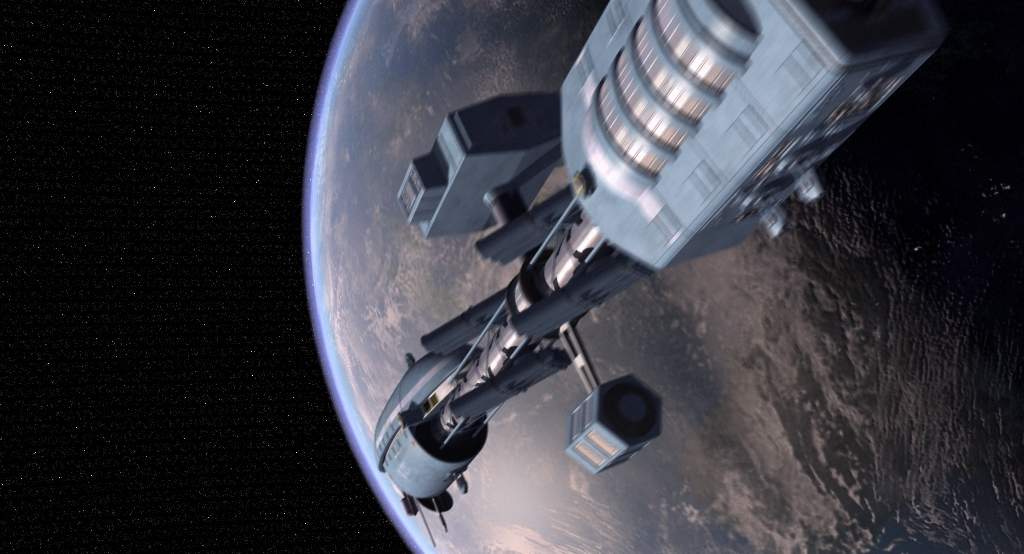
|
Above: Algerie operating in the Alpha Centauri system in 2292 during the War of Reunification executing a fast pass of Tirane en-route to intercepting a suspected German privateer. (Image courtesy of L'Autre Monde.) Introduction The ships of the Patrie and Soldat Class are the mainstay of the MSIF's destroyer fleet and have only recently been supplanted by the Paris and Planète classes. These ships have had a long gestation period, delayed by over ambitious specification and technology. However they proved a noticeable step-up in capability and have laid the foundations for more modern designs. Although mostly stationed in the Core, the Kafer War has seen these ships win their spurs in fighting on the French Arm. Acknowledgements All pictures in this article are by Laurent Esmiol. Thanks to Dan Hebditch for feedback and narrative. Narrative The Lansquenet hung silently just beyond the edge of the DM+36 2393 system’s
FTL shelf, just slightly off axis from the direct route to Hochbaden,
a further three human warships were also covering this route. The Maréchal Ney was in close
attendance but the two Australian vessels were lurking in-system, watching
and waiting. DM +36 2393 was the last human colony still occupied by the Capuchons and
was a formidable citadel. The remnants of the alien Task Forces that
had ravaged the Beta Canum Cluster had fallen back here after the defeat
at Beowulf. The Capu fleet, tagged as Task Force Tango, was a disparate
body that had spent much of its time fighting amongst itself to establish
a working command structure. However it had enough combat power to stave
off of a badly co-ordinated attempt by Rochemont’s Fleet to bounce them
out of the system. Now human space and ground forces were massing for the final liberation.
Fast, highly capable ships had been tasked to scout and interdict the
system. The Gloire had picked off a Beta as it attempted to slip into the
sanctuary of the system, but the main effort was to close off DM +36
2393 from supplies slipping through from Kafer space. Borodin’s Fleet
couldn’t piquet Hochbaden or DM +18 2776 in enough strength to stop
all the convoys. But they could provide advance warning of their arrival
at DM +36 2393. The Lansquenet had been close enough to run into an ambush position, despite
having been out on an already extended patrol. However the opportunity
to assault a Capu convoy was too good to pass up. Their arrival was
imminent as a squadron of two Epsilons with escorting fighters
was on the move from their usual position around Dunkelheim. Then they
were there. The convoy, ten Oscars and an Epsilon, flashed
across the FTL shelf and came to a relative halt. Although they were
still moving at a high percentage of c on the tactical display
it almost looked as if they’d hit a wall. The Australians moved first, powering towards an intercept with the convoy.
The Capus knew the signature of the Australians well by now, Bushranger especially
had been a thorn in their side for years. The Epsilon from the
convoy reacted to protect its charges, accelerating towards the human
ships and deploying a screen of missiles. The Aussies rapidly turned
tail, drawing the Epsilon after them, the Capu squadron coming
out from Dunkelheim shaped to follow them too. The Australians played
their role to perfection. The Lansquenet and Maréchal Ney came across
the FTL shelf with missiles deployed. They were on the heavily laden,
lumbering Oscars in minutes. It looked like the ambush was going
to work. |
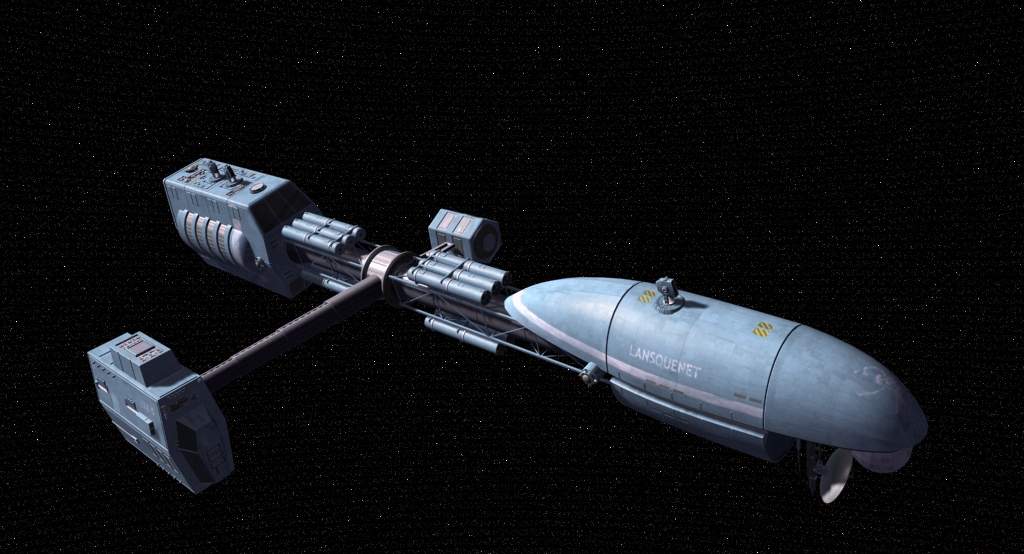
|
Above: Lansquenet at a deep space supply rendezvous somewhere in the Eta Bootis Finger late in 2302. Assigned to the French 3rd Fleet the ship was part of the force assigned to the interdiction of DM+36 2393 (Image courtesy of MSIF Media Ops.) By
the middle of 2270s the renewal of the French destroyer (“torpilleurs”)
fleet was underway. The old Odysseus-class
was beginning to be phased out by the new Maréchal-class
but half of the medium-sized ships were still of the older class. The
Maréchaux were potent ships having been
the test bed for the technologies planned for the future Suffren-class. However it was understood that these destroyers couldn’t
match the expected warp efficiency of the planned cruisers. A new “flanker”
had to be designed and Maréchal-class
production was phased out after 7 ships. A
team of space naval architects began their work on the new class in
2277. The requirement was for a faster and more subtle ship using the
latest developments in space technologies to reduce running costs without
losing performance. Several of these technologies were delayed by developmental
difficulties resulting in the project progressing very slowly during
the initial stages. Meanwhile
tension between With development on the new battleship class nearly complete the advanced technologies initially planned for the class were made available by 2285 and the final design reached the desired capabilities. The final design was immediately ordered and these ships were considered a separate class and named after types of historical soldiers. Despite a quick construction period the first ship was finished after the end of the Central Asian War. Work on the follow on ships was slowed and completion delayed by budgetary constraints. The crash program launched during the War of German Unification allowed the four unfinished ships to be completed. At last, the fleet received destroyers with a combat warp efficiency allowing the formation of powerful task groups centred on the mighty Suffren cruisers.
|
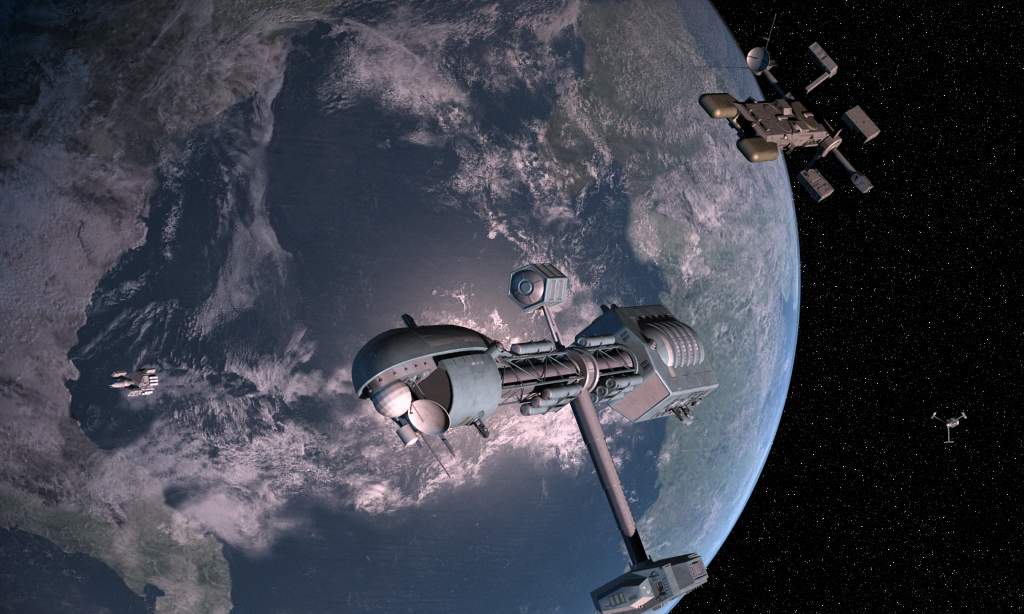
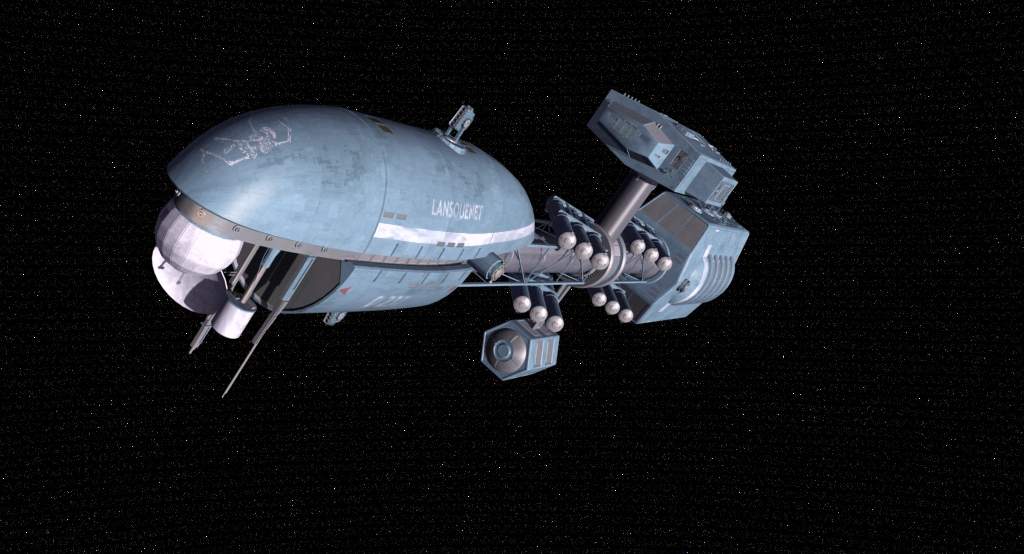
|
Three
decisions defined the philosophy of the design from the beginning of
the work: -
Dedication
of the ship to fleet actions as the long range strike power of a group.
No luxuries such as a scientific section or a troop of marines were
carried. This was the true difference with more versatile ships like
Maréchaux. -
First
large use of the advanced materials made available by the beanstalk
project and already used in the Mistral-IIIB
development. These lightweight materials allowed an elongated hull keeping
a strong structural resistance. -
Use
of non-energy weapons to maximise the drive efficiency of the ship.
This thought was widespread in the French space naval architect community
and nearly all small crafts designed after 2284 carry this kind of weapon. Hull design The hull is composed of four distinct parts. -
The
armoured bow is the command section containing the bridge, TAC, sensor
systems, 0G crew accommodations and part of life support systems. -
The
unarmoured axis contains the spin machinery and carry the torpedoes
launchers. -
The
unarmoured habitat contains the micro-gravity crew accommodations and
the medical bay. Fully extended it allows a 0.20G pseudo gravity with
a 2.5 rpm rotation. -
The
armoured stern is the engineering section containing the fission reactor,
warp engine, small cargo area and fuel tanks. A magnetic sling is available
on each side of the section. Two materials have been used to construct
the hull. The well known RTS 6 advanced synthetic, pioneered in the
Orage-class frigate is used for the unarmoured
sections while a newly manufactured advanced composite, RSC 10, is used
for the other sections. The new material is still under survey nearly
20 years after the first commitment to study the effect of ageing of
in space. Overall dimensions: -
Length: 76 m. -
Largest Width: 12 m -
Largest Height 12 m -
Tonnage: 3464 metric tons for PATRIE-class. 3490 metric tons for SOLDAT-class. Armament With
time the armament carried by these destroyers has changed and each division
is slightly different from others one. The initial layout was: -
6
x Guiscard LL-98 or LL-120 laser weapons mounted on six UTES equipped
turrets. -
12
x RITAGE-1 carried in four launchers located amidships with three remote
piloting stations. -
6
x Brand LL-2 submunitions dispensers located at the bow and stern. Remarks: -
The
torpedoes have been upgraded to the R1-DT standard during the last months
of 2301 and DA2290 have been occasionally carried during the War of
German Reunification. -
The
availability of the 5x2 warheads carried by the DA-2290 allowed some
ships to replace one LL-2 dispenser with the more powerful LL-7 (6 5x2
warheads). Electronics Sensor
systems are provided by DARLAN
OPTO-PHYSIQUE while the targeting computer is part of the P-21T
integrated fighting system provided by ROCHARD. -
Active-Passive
with two working stations: -
DSAP
S-2275. (Active: 7, Passive 3) -
Passive
with one working station: -
DSMSP
S-2278T (Passive: 10) for
Patrie. -
DSMSP
S-2293T (Passive: 12) for
Soldat. -
These
systems are specially derived for destroyers (“Torpilleurs”) from the Suffren or
Gloire sensor suits. -
Standard
Navigation systems, Gravitational sensors, Deep system scanners. Stealth
Characteristics -
Radial
surface: 157 square meters. -
Lateral
surface: 701 square meters. -
Advanced
masking system. Engineering
Systems -
Power
Plant: ALSTHOM 35Mw fission
reactor. -
Fuel:
25 cubic meters to refuel utility shuttles docking with the ship. -
Drive:
ROUCHARD-LIGGET “Propulseur
Jérôme” PJ-35; 35MW old military on PATRIE or PJ-35Mod2 new military on
SOLDAT. Crew The
two classes have a standard crew of 55 men sharing 35 workstations.
These stations are located as follows: -
6
in bridge. -
12
in TAC -
13
in engineering. -
1
in troop bay. -
1
in steward office. -
2
in medical bay. Living
conditions aboard these ships have been described as “cramped” with
only half of the 25 cubic meters per crewman located in the micro-gravity
habitat. Ships are sometimes compared with ancient submarines, but great
care has been taken to help the crew to endure long range missions.
A minimum of systems intrude in the living area and video walls project
views of natural landscapes (thanks to the medics acting as psychological
counsellors). Despite this help, the Patrie/Soldat
destroyers are mostly based in the core leaving long-term colonial
duties to the roomier Maréchal and Aconit. INDEX |
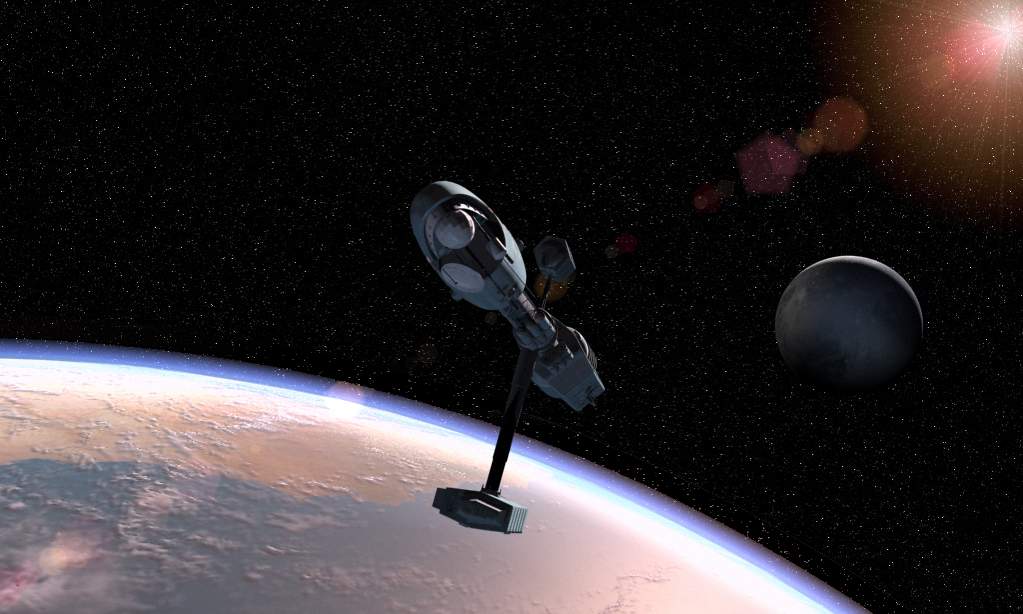
Above:
Bretagne in 2285 above Earth following her succesful acceptance trials.
(Image courtesy of MSIF Media Ops.)
Performance
PATRIE Warp Efficiency: 3.14 Combat/ 3.47 Travel, Fuel: 20 tons (1 refuel for utility shuttle), Cargo:
7 cubic meters, Life Support: 90 days, Comfort: 0, Price: 70 Mlv. Ship Status Sheet
Hits Bridge: Captain, Helm, Navigator, Communications,
Engineering, Computer. TAC: Active Sensors, 2xPassive Sensors, 6xFire Control,
3xRemote Operators Hull Hits: 46 using Bryn’s rule (106 using NAM) Power Plant Hits: 46/9 Damage Control: 5 teams (13) SOLDAT Warp Efficiency: 3.33 Combat/ 3.77 Travel Fuel: 20 tons (1 refuel for utility shuttle), Cargo:
4 cubic meters, Life Support: 90 days, Comfort: 0, Price: 97.8 Mlv. Ship Status Sheet
Hits Bridge: Captain, Helm, Navigator, Communications,
Engineering, Computer. TAC: Active Sensors, 2xPassive Sensors, 6xFire Control,
3xRemote Operators Hull Hits: 46 using Bryn’s rule (106) Power Plant Hits: 46/9 Damage Control: 5 teams (13) INDEX |
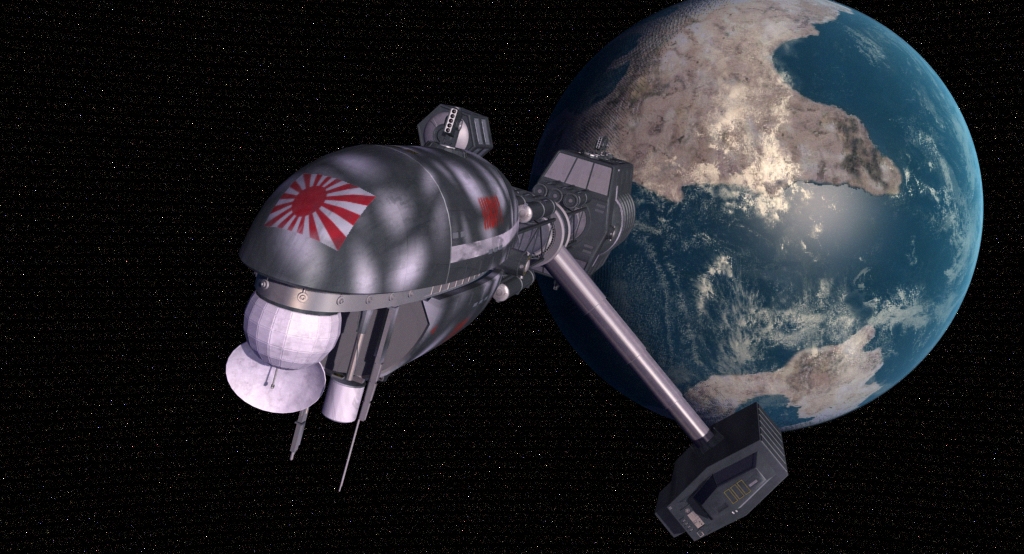
|
Above: The Japanese destroyer Hibiki on patrol in the Kimanjano system. She would later be very badly damaged here in combat with the Kafers. (Image courtesy of JSDF.) Appendix 1Ritage-1DT
(“Détonation - Torpilleurs”)
The
Ritage-1 missile system has armed French vessels since the 70s and were
planned to be replaced on a one for one basis by the powerful Ritage-2.
For years the MSIF had been reluctant to study improvement of the fighter
drone into a true torpedo as proposed by industry and adopted by several
space forces. The fear of a possible cancellation or cut in the Ritage-2
program was too strong. The
Kafer war has changed the carefully studied deployment. The R-2 rate
of production will never allow the re-equipment of all ships while supplying
frontline units. Consequently a crash program has been launched in the
days since news of the Invasion reached Earth. Major stocks of R-1 are
being updated by replacing the laser, capacitors and sensors by a reliable
5x2 warhead. The warp-engine is refitted during the process and a small
margin of efficiency could have been gained, but this information has
not been confirmed by the MSIF public relations department. This
missile is available to the MSIF after October 2301 to arm destroyers
and some fleet frigates. Performance : Warp
Efficiency: officially 3.38 but could reach 3.45. Power
Plant: 0.1MW Fuel Cell Fuel:
0.27 tons; Mass:
10.72 tons Armament:
5x2 Detonation Laser Length:
5m Diameter:
1m INDEXAppendix 2Hibiki -class Destroyer
The
development of the Patrie was closely followed by several nations
yet only Japan expressed an interest in acquiring a licence to produce
their own version of the ship. Whilst utilising the design of the Patrie
many of the sub-systems, including all of the electronics fit, are of
Japanese design. The Hibiki class are believed to be equivalent
to the Soldats in performance, although the exact data has never
been revealed. The
Japanese Space Defence Force has at least four of these destroyers which
form the mainstay of their destroyer force. Two, the Hibiki and
Terutsuki, were heavily involved in action on the French
Arm and the Hibiki was almost lost with all hands. However it
is testament to the toughness of the design that her crew managed to
extract her from combat around Kimanjano. |
